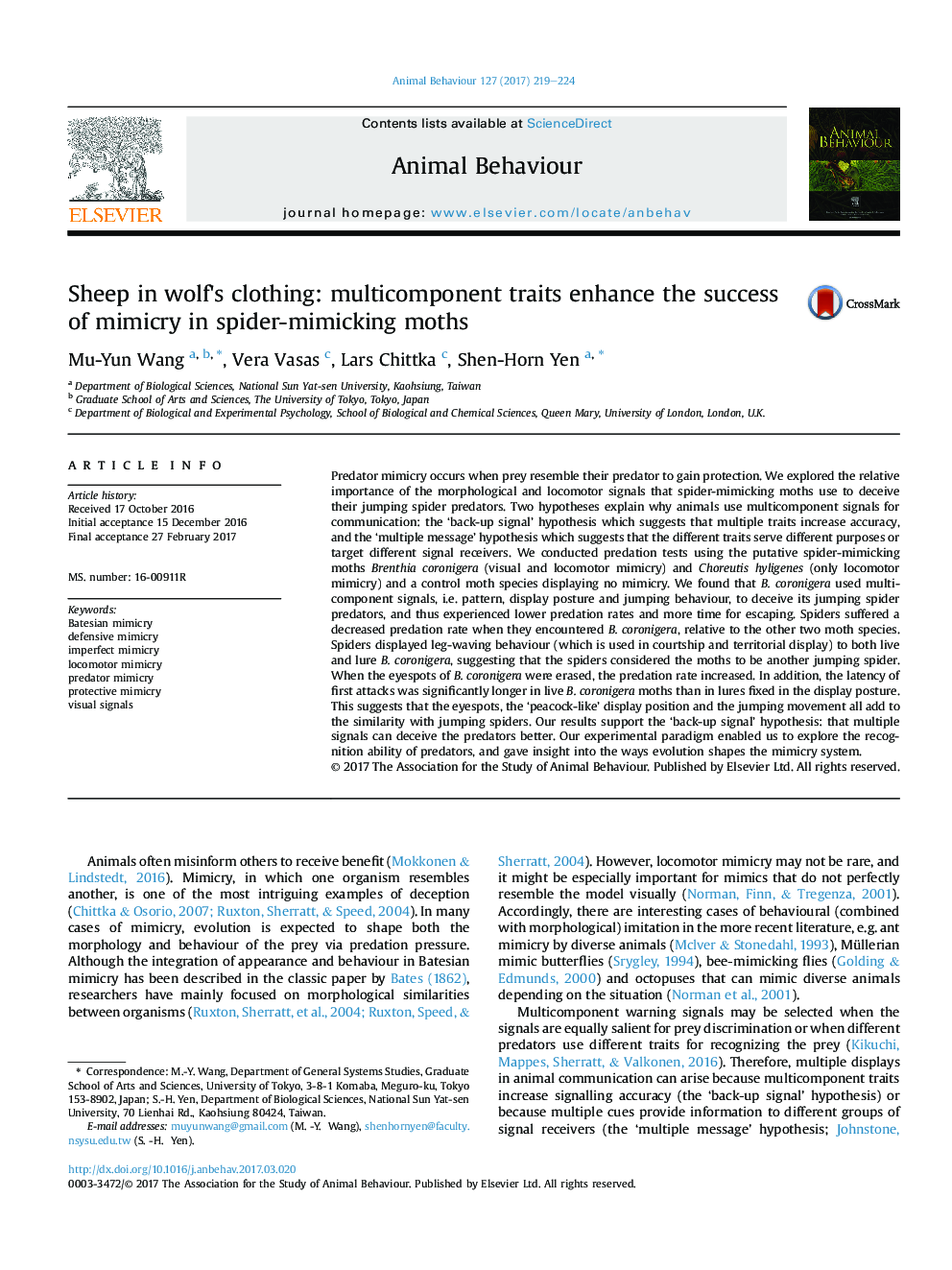| کد مقاله | کد نشریه | سال انتشار | مقاله انگلیسی | نسخه تمام متن |
|---|---|---|---|---|
| 5538354 | 1552201 | 2017 | 6 صفحه PDF | دانلود رایگان |
عنوان انگلیسی مقاله ISI
Sheep in wolf's clothing: multicomponent traits enhance the success of mimicry in spider-mimicking moths
ترجمه فارسی عنوان
گوسفند در لباس گرگ: صفات چند قطعه ای از موفقیت تقلید در موش صحرایی عنکبوت را افزایش می دهد
دانلود مقاله + سفارش ترجمه
دانلود مقاله ISI انگلیسی
رایگان برای ایرانیان
کلمات کلیدی
تقلید بتسیان، تقلید دفاعی، تقلید ناقص، تقلید حرکتی، شکارچی تقلید، تقلید محافظ، سیگنال های بصری،
موضوعات مرتبط
علوم زیستی و بیوفناوری
علوم کشاورزی و بیولوژیک
علوم دامی و جانورشناسی
چکیده انگلیسی
Predator mimicry occurs when prey resemble their predator to gain protection. We explored the relative importance of the morphological and locomotor signals that spider-mimicking moths use to deceive their jumping spider predators. Two hypotheses explain why animals use multicomponent signals for communication: the 'back-up signal' hypothesis which suggests that multiple traits increase accuracy, and the 'multiple message' hypothesis which suggests that the different traits serve different purposes or target different signal receivers. We conducted predation tests using the putative spider-mimicking moths Brenthia coronigera (visual and locomotor mimicry) and Choreutis hyligenes (only locomotor mimicry) and a control moth species displaying no mimicry. We found that B. coronigera used multicomponent signals, i.e. pattern, display posture and jumping behaviour, to deceive its jumping spider predators, and thus experienced lower predation rates and more time for escaping. Spiders suffered a decreased predation rate when they encountered B. coronigera, relative to the other two moth species. Spiders displayed leg-waving behaviour (which is used in courtship and territorial display) to both live and lure B. coronigera, suggesting that the spiders considered the moths to be another jumping spider. When the eyespots of B. coronigera were erased, the predation rate increased. In addition, the latency of first attacks was significantly longer in live B. coronigera moths than in lures fixed in the display posture. This suggests that the eyespots, the 'peacock-like' display position and the jumping movement all add to the similarity with jumping spiders. Our results support the 'back-up signal' hypothesis: that multiple signals can deceive the predators better. Our experimental paradigm enabled us to explore the recognition ability of predators, and gave insight into the ways evolution shapes the mimicry system.
ناشر
Database: Elsevier - ScienceDirect (ساینس دایرکت)
Journal: Animal Behaviour - Volume 127, May 2017, Pages 219-224
Journal: Animal Behaviour - Volume 127, May 2017, Pages 219-224
نویسندگان
Mu-Yun Wang, Vera Vasas, Lars Chittka, Shen-Horn Yen,
